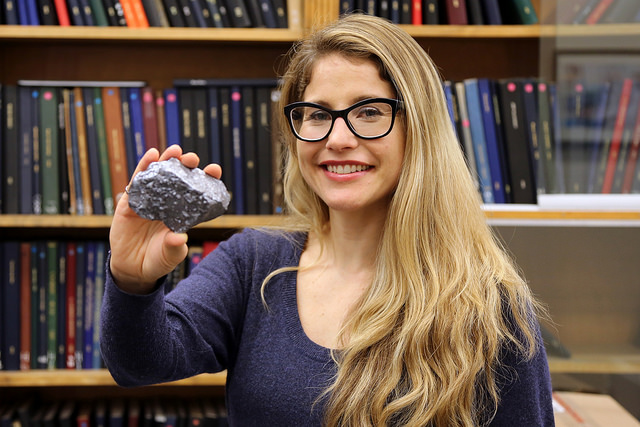
Photo: Professor Erin Bobicki researches new methods for extracting valuable minerals that use less energy and water than current methods. Her innovations could also enable the extraction of useful metals from materials previously discarded as waste. (Credit: Kevin Soobrian)
February 1, 2017 | By Tyler Irving
This story is the second in the U of T Engineering News five-part #RisingStars series, highlighting the work of early career professors.
Professor Erin Bobicki (MSE, ChemE) is working to reduce the environmental impact of mining and mineral processing — and her secret weapon is a common household appliance.
“I basically did my PhD by putting rocks in a microwave,” she says. “I drilled a hole in it and put a small reactor vessel inside.”
While this should definitely be left to the professionals, her hacker’s approach is grounded in sound science. Mineral processing is all about separating valuable metals such as nickel, copper and zinc from the low-value minerals — known as gangue — that make up most of the ore. Many high-value compounds respond differently to microwaves than less valuable ones.
“Minerals have different dielectric properties, and in some cases different magnetic properties, that make them react differently to the electromagnetic radiation produced by microwaves,” says Bobicki. “By playing with those properties, we can encourage cracks at the boundaries between the valuable grains and the gangue.” Microwaves can also alter the surface chemistry and composition of mineral grains, making it easier to separate the valuables from the gangue in downstream processing.
The microwave idea is just one of many ways that Bobicki and her team hope to help mineral processors save energy, consume less water and reduce waste production. All of this draws on Bobicki’s multidisciplinary expertise in materials science, environmental engineering and chemical engineering. Before joining the Faculty in January, Bobicki worked in both the mineral processing and the semiconductor industries, including a two years as a mill metallurgist in Labrador.
“I love the feel of a mineral processing plant: it’s big, loud, shiny and tactile. You can physically see what you’re producing,” says Bobicki. “At the same time, I’ve always been very passionate about environmental issues, and I know that there is a lot of potential for movement in that direction.”
Bobicki is particularly interested in low-grade ore, including material dumped as waste. “Many processors have issues with historic tailings that they have to manage, but there is also a huge resource in those tailings,” says Bobicki. “Extraction techniques in the past were not as good as they are now. If we can improve them still further, we could actually process that waste into valuable material.”
One way to extract more value from low-grade ore would be to improve the process of comminution — breaking up multi-tonne slabs of rock into particles the size of grains of sand and smaller. Comminution frees the valuable particles from the surrounding gangue and makes it easier to move materials through the processing plant. It’s also very energy-intensive.
“Comminution is one of the industry’s least efficient processes: as little as one per cent of the energy we put in actually goes into breaking a particle,” says Bobicki. If microwave pre-treatment or other techniques can reduce the energy input required for comminution, ores that were previously too costly to process could suddenly become more economical.
The technical challenge of trying to do more with less is a big part of what drives Bobicki to do this work. “There are a lot of exciting things going on in this field,” she says. “I just love it, and I want to get students as excited about mineral processing as I am.”
Hear from Prof. Erin Bobicki at our MSE Impact Speaker Series on February 16, 2017